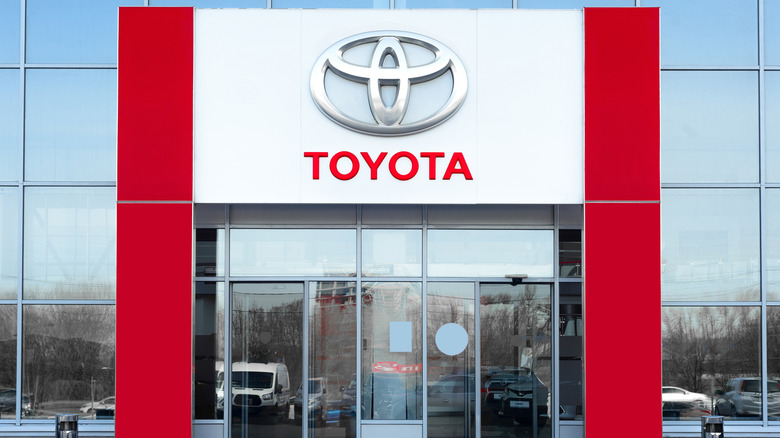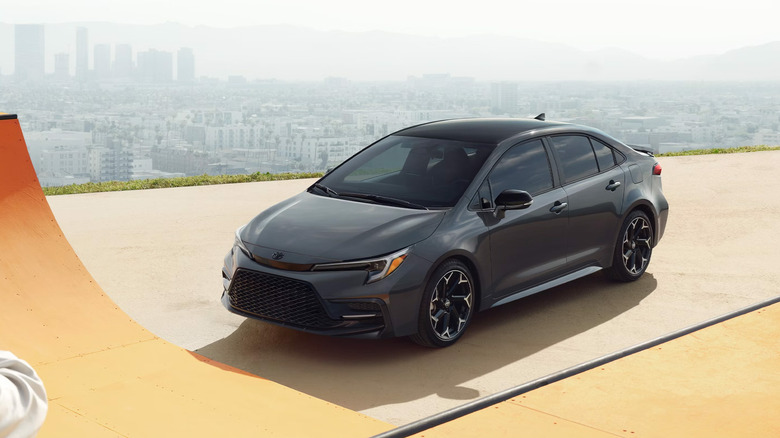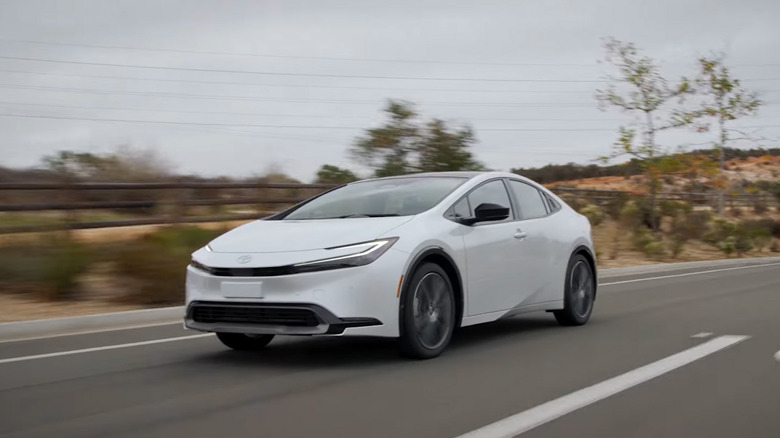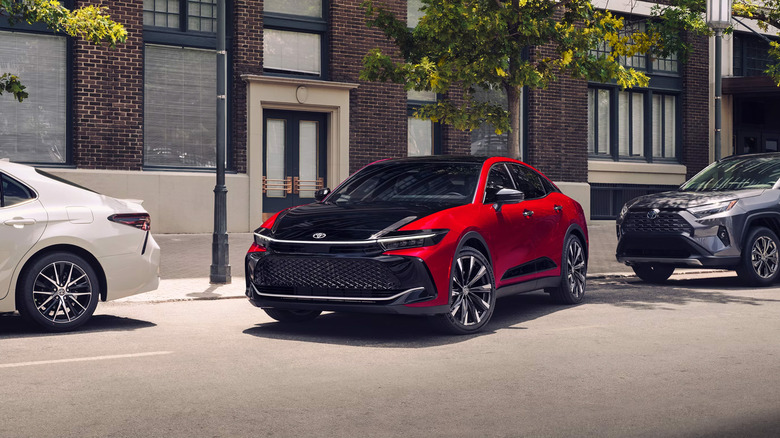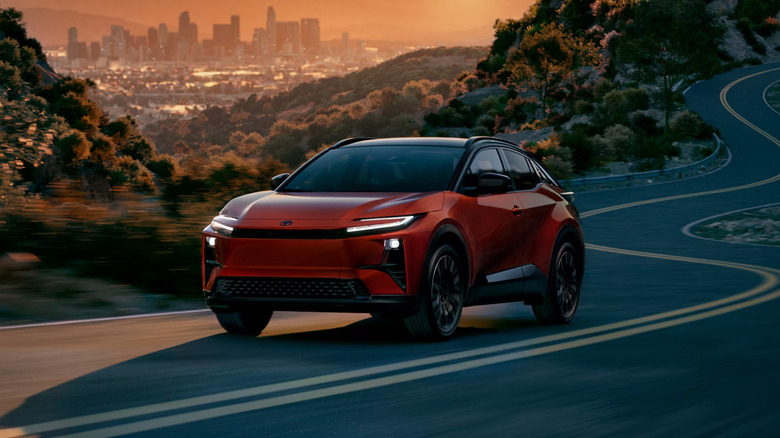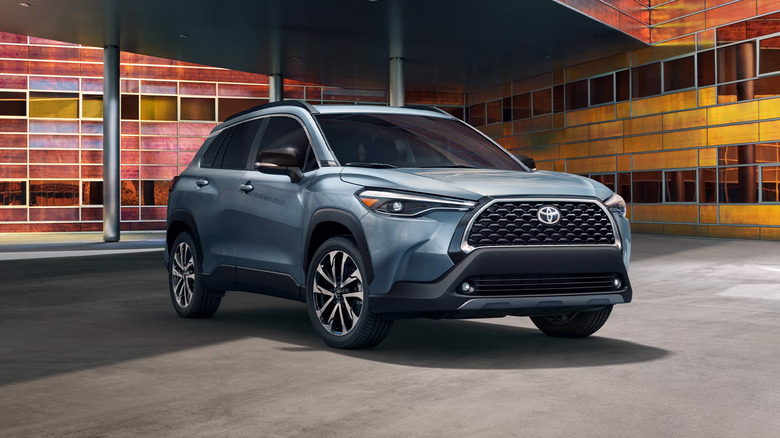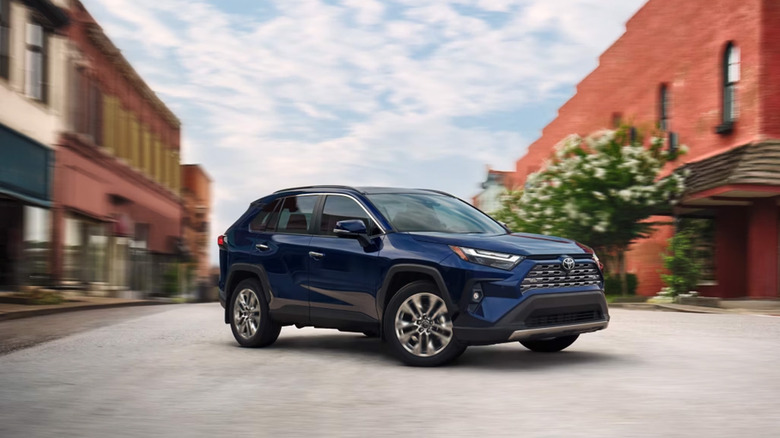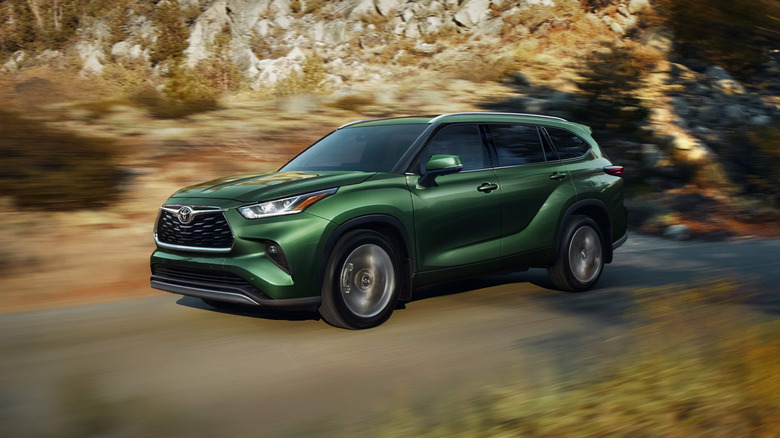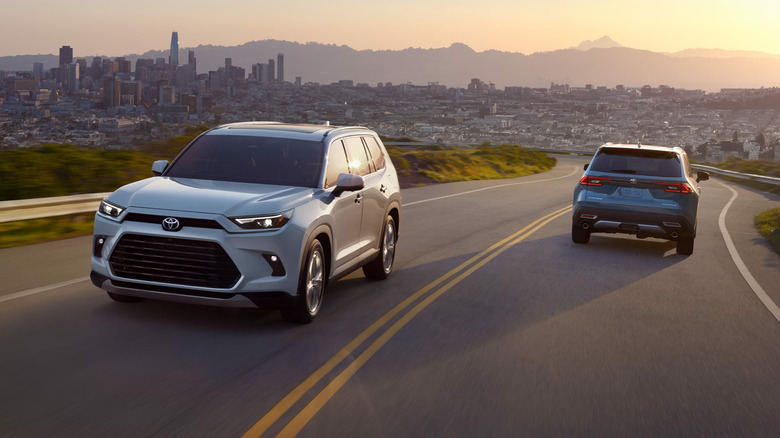Every Toyota Model With A CVT Transmission
Continuously variable transmissions — or CVTs — aren't the most favored transmission among enthusiasts, but for the average driver, they are actually pretty good. CVTs operate by using belts and pulleys to continuously change the gear ratio in the transmission. This gives power when you need it, while avoiding the jerky shifts of an automatic transmission. There are plenty of advantages, such as always being in the correct gear ratio for whatever type of driving you're doing, and smoother overall operation. For that, you exchange the classic CVT droning sound, since your car is being held at proper RPMs all the time, and having to unlearn the muscle memory of automatic transmission's shifts.
However, the biggest pro to having a CVT is outstanding fuel efficiency. Vehicles equipped with one of these things generally get more miles per gallon than the same car with an automatic transmission, and that's why automakers have started leaning on them a lot. Toyota is one of those automakers, and the company uses its CVT transmissions in most of its product lineup these days. You'll find them especially common in hybrids, where fuel economy is paramount.
So, if you're shopping for a Toyota and you want a CVT, the list below contains all of the vehicles that Toyota sells in the U.S. that comes equipped with one. Alternatively, if you don't want a CVT, you can still use the list below to avoid getting one if you don't want it.
Toyota Corolla and Corolla Hybrid
Let's start with the humble Toyota Corolla. This little economy car has been long known for its excellent fuel efficiency. Per Fuelly, even a Corolla from 15 years ago averages around 30 mpg in real world conditions, which only marginally worse than the non-hybrid 2025 model. Toyota sells two variants of the Corolla these days, one with a hybrid powertrain and one without. Both are equally capable and efficient for their respective segments, but the hybrid version can top 50 mpg with all-wheel drive, making it the most efficient Corolla that Toyota makes.
When it comes to CVT transmissions, the Corolla keeps it simple. Almost every variant of the Corolla comes with a CVT transmission, regardless of its powertrain. The only model that doesn't have a CVT is the speedy Toyota GR Corolla, which features a three-cylinder engine tuned to 300 hp. That one comes with either an eight-speed automatic or a six-speed manual transmission. You'll also get much worse fuel economy with the GR Corolla in exchange for it being way more fun to drive. The EPA estimates that a GR Corolla will get 21 mpg in the city and 28 mpg on the highway.
So, if you're on the showroom floor and you want a CVT, you can pick any Corolla other than the GR variant. You can choose the GR variant if you want something more engaging and fun at the cost of fuel efficiency.
Toyota Camry
Stepping up to the next price tier is the Toyota Camry. This has long been one of the most popular vehicles in North America. It makes sense. Toyota combines excellent fuel economy with a nice riding vehicle that comes with enough bells and whistles to please most people. It's also one of the few inexpensive sedans that come with all-wheel drive, a boon for those in wintry climates. Toyota's all-wheel drive system is also unique in the Camry. The front-wheel drive model comes with a 2.5-liter four-cylinder engine and two electric motors. Opting for AWD ads a third motor that runs the rear tires and increases horsepower to 232.
Like the Corolla, Toyota keeps it simple with the Camry. Every Camry comes with a CVT, regardless of trim. This is new for Toyota. For 2025, the brand abandoned all regular gas engines in favor of only hybrid powertrains. That means the non-hybrid four-cylinder and the peppier 301-hp V6 are gone along with the eight-speed automatic transmission that Toyota paired them with. On the one hand, it makes shopping a lot easier for consumers, but it comes at the cost of choice.
Fortunately, the hybrid Camry is pretty good. Like its smaller sibling, the Camry can hit 50 mpg or more in the city even with all-wheel drive. It does so while still being able to reach highway speeds in under seven seconds, which is swifter than many regular gas engines in the segment.
Toyota Prius
The Toyota Prius was the world's first mass-produced hybrid vehicle, and it is the best-selling electrified vehicle of all time. It's also the original hybrid with a CVT, being equipped with one since it entered the market in 1997. So, you can probably guess how this goes. One of the biggest detriments to the Prius was how slow it was, with earlier models taking over 10 seconds to reach highway speeds. However, this is something Toyota corrected with later models, and the 2025 Prius is easily one of the best hybrids on the market.
As you may have surmised, every model of the Toyota Prius comes equipped with its hallmark hybrid engine and CVT transmission. The big difference is in engine power. Modern variants of the Prius have a 2.0-liter engine with a pair of electric motors that make a total of 194 hp. Like the Camry, Toyota adds another electric motor to the rear axle for all-wheel drive variants that makes a grand total of 196 hp.
This may not seem like a lot, but it completely changes how the Prius acts on the road. Whereas prior generations would get to highway speeds eventually, the newer Prius models can get there in about 7 seconds, which is much more reasonable. The plug-in hybrid model is even faster thanks to its 220 hp drivetrain. For shoppers, choosing between this and the Camry comes down to personal preference as they're both competent vehicles.
Toyota Crown
The Toyota Crown hybrid goes for near-luxury car prices and looks striking, but just because it's at the top of Toyota's sedan family doesn't mean the company treats it any differently. All models of the Crown come with a hybrid powertrain, just like the Corolla, Camry, and Prius. The difference is power. The Crown comes with a 2.5-liter engine with three electric motors that output a total of 236 hp, while the Hybrid Max-equipped Platinum trim version gets a 2.4-liter four-cylinder and an electric motor that is good for 340 hp.
All models of the Crown come with all-wheel drive, but not all of them come with a CVT. The Platinum trim of the Crown comes with a six-speed automatic that sets it apart from the others. Every other Crown except the Platinum trim gets a CVT. We're not sure why Toyota didn't just use a CVT on every trim, but the inclusion of the stronger engine suggests that it's more fun to drive, so the six-speed may be for driving enthusiasts who don't want a CVT. The Platinum trim does scoot to 60 mph about two seconds faster than the other trims.
There is some subject to debate on whether the Crown is an SUV or a sedan. However, Toyota does list it alongside its other sedans, so we're going to call it one until Toyota says otherwise.
Toyota C-HR
Technically, the Toyota C-HR isn't sold new in North America anymore. The automaker's smallest crossover was discontinued after the 2022 model year. The most likely reason is because the Corolla Cross and Corolla Cross Hybrid exists, which made the C-HR redundant. It may not be the last that the U.S. sees of the plucky subcompact as Toyota is bringing it back as an EV for the 2026 model year, and yes, it'll be sold on U.S. shores. In any case, it's likely that you'll see some of the old versions hanging out on dealership lots, so it's worth talking about them for a minute.
The final model of the C-HR in North America was the 2022 model and every version of it used a CVT. That, plus its lackluster four-cylinder engine, caused the C-HR to be even slower than older Prius models, with highway speeds being achieved eventually, but not quickly. Toyota still makes the C-HR in other countries and all versions of that also use a CVT exclusively. However, unlike the 2022 model, the 2025 C-HR has three drivetrain options, including a hybrid and plug-in hybrid version.
When the C-HR makes its triumphant return to the U.S., it won't come equipped with a CVT. In fact, most EVs don't use traditional transmissions at all. Most EVs use a direct-drive system that is mostly just a single-speed automatic transmission, which the C-HR will almost certainly also have.
Toyota Corolla Cross
With the C-HR gone, the Toyota Corolla Cross is the smallest crossover in Toyota's lineup. The car has a lot in common with most other subcompact crossovers, including a fuel-efficient engine that is light on the fun and mild driving manners. Unlike the sedans, the Corolla Cross has both a standard gas engine and a hybrid powertrain to choose from. The former uses a 2.0-liter four-cylinder that outputs 169 hp while the hybrid model sports the same gas engine along with three electric motors that top out at 196 hp. That extra strength really helps the Corolla Cross get to highway speeds faster than the gas variant.
Much like many other Toyota models these days, all versions of the Corolla Cross come with a CVT. The gas-only variant has front-wheel or all-wheel drive options while the hybrid version is all-wheel drive only. At this point, we're not sure why Toyota bothers with an ICE version since the hybrid comes better equipped all the way around. Price likely has something to do with it. The base model ICE model starts at around $25,000 while the hybrid starts at nearly $30,000.
Regardless of which one you go with, the fuel economy is pretty good. The gas Corolla Cross gets 31 mpg in the city and 33 on the highway, while the hybrid model ups that to 45 mpg in the city and 38 on the highway.
Toyota Rav4 Hybrid
The Toyota Rav4 is the first vehicle in Toyota's lineup that doesn't include a CVT. All of the regular gas models come with a four-cylinder engine that makes 203 hp, paired with an eight-speed automatic transmission and all-wheel drive as an option. That's fairly standard for the intensely competitive crossover segment. Since the Rav4 recently took the Ford F-150's sales crown as the most popular vehicle in the U.S., we understand why Toyota may not want to mess with that recipe just yet. The Toyota Rav4 Hybrid, on the other hand, is a different story.
The Rav4 Hybrid falls more in line with Toyota's other vehicles — every version of it sports a CVT, including the plug-in hybrid version. It's paired to a 2.5-liter four-cylinder and three electric motors that generate a total of 219 hp. As with most Toyota hybrid drivetrains, the existence of three electric motors denotes all-wheel drive, which does, in fact, come standard on the Rav4 Hybrid. As such, the hybrid model is more fuel efficient and faster than its regular gas counterpart.
Of the two, it's pretty clear which version is better. The Rav4 Hybrid gets 40 mpg combined versus the roughly 30 mpg that the regular gas Rav4 can get. Even the price isn't that big of a difference since the base model hybrid is only a few thousand dollars more expensive than the gas model. The plug-in hybrid model is much more expensive, though.
Toyota Crown Signia
The Toyota Crown Signia sits in a weird spot in Toyota's lineup. Unlike the regular Crown, the Signia is definitely an SUV. However, it's name makes it sound like an extra trim level of the sedan. Plus, the Signia gives off some station wagon vibes, which gives it a little extra charm compared to the rest of the brand's SUV lineup. Its design its complicated, but its powertrain is not. Every model of the Signia comes with an all-wheel drive hybrid powertrain. It sports a 2.5-liter four-cylinder engine and three electric motors that give it 243 hp. Weird it may be, but it's not wanting for day-to-day power.
Like virtually every other all-wheel drive Toyota with a hybrid powertrain, the Signia sports a CVT exclusively. That setup grants the oddball wagon-SUV hybrid with around 38 mpg combined, which is only slightly worse than the Rav4 Hybrid. In return, you get the Signia's more luxury-oriented styling both inside and out. when comparing the two, shoppers often remark that the interior of the Crown is more well-appointed than its Rav4 counterpart. That's about the only comparison to be made since both go about as fast as one another.
The other big difference between this and the Rav4, aside from styling, is the price. The Signia has only two trim levels and both of them are very well equipped. By contrast, the Rav4 has seven trim levels and the most expensive is still cheaper than a base model Signia.
Toyota Highlander Hybrid
The Toyota Highlander is a lot like the Rav4 in Toyota's lineup. The gas-only model features a turbocharged 2.4-liter four-cylinder that pumps out 265 hp and is mated to an eight-speed automatic transmission. This seems to work well for the SUV since it gets to 60 mph in a reasonable seven seconds while also returning decent fuel economy for a three-row crossover. It also helps that the Platinum trim borders what luxury vehicles offer. The hybrid model is similarly powerful with its 2.5-liter four-cylinder and three electric motors churning out 243 hp.
If you've noticed the pattern then you know what the next sentence is going to say. All models of the Highlander Hybrid come equipped with a CVT and with the three electric motors, that means it comes with all-wheel drive by default. The Highlander Hybrid matches its gas-only variant in terms of speed with that engine setup while also returning nearly 10 mpg more in all driving scenarios. Outside of the predictably higher price tag, that makes the Highlander Hybrid all-around better in every arena except towing. The hybrid model can carry 3,500 pounds and the gas variant can do 5,000 pounds.
In all, the Highlander really does share a lot of commonalities with the Rav4. The gas model is stronger and less expensive but also returns lower fuel efficiency. For a few more dollars and lower towing capacity, you can get superior fuel economy.
Toyota Grand Highlander Hybrid
Toyota didn't change much in terms of powertrain options with the Grand Highlander. In fact, the drivetrain is exactly the same. The gas-only Grand Highlander sports the same 2.4-liter turbocharged four-cylinder that outputs the same 265 hp and is equipped with the same eight-speed automatic as its smaller sibling. As with the regular Highlander, all-wheel drive is optional on the Grand Highlander. The hybrid model is where things differ quite a bit. Unlike the Highlander Hybrid, the Grand Highlander is more in line with the Toyota Crown when it comes to its drivetrains.
There are a total of two powertrain options with the Grand Highlander. The first is a 2.5-liter four-cylinder with two electric motors that outputs 245 hp and optional all-wheel. This is on the LE, XLE, Nightshade Edition, and Limited trims and comes exclusively with a CVT. The other is Toyota's Hybrid Max system, which pairs a turbocharged 2.4-liter engine with an electric motor to pump out 362 hp. That engine is an available option on the Limited trim and standard on the Platinum trim. Like the Crown, the Hybrid Max powertrain comes with a six-speed automatic transmission.
In all, most reviewers actually recommend the CVT-equipped 2.5-liter engine over the Hybrid Max. The Hybrid Max is undeniably faster, but only by about 1.5 seconds when comparing 0-60 mph times. For fuel economy, the base engine gets roughly 10 mpg more than the Hybrid Max version as well.
Toyota Sienna
The humble Toyota Sienna finishes off our list, and for good reason. Toyota electrified the Sienna in 2021, and all models since then have come with a hybrid powertrain. It's very similar to the one found in the Grand Highlander. The 2025 Toyota Sienna has a 2.5-liter four-cylinder engine with two electric motors that output 245 hp. Opting for all-wheel drive adds a third electric motor, as is normal with all-wheel drive Toyotas these days. The third electric motor doesn't increase the horsepower in the Sienna, which is a little unusual since it does on other models.
In any case, for the final time in this article, all models of the Sienna come equipped with a CVT. It feels really good knowing that I don't have to type that sentence again. Jokes aside, the powertrain in the Sienna is surprisingly capable. It reaches 60 mph in about 7.5 seconds, which is good enough for hauling kids around all day. Fuel economy is also decent at 36 mph combined. That was easy to figure out because it gets 36 mph in the city and also 36 mph on the highway as rated by the EPA. In most testing, the Sienna meets or exceeds its fuel economy estimates.
For the most part, Sienna fans don't miss the throaty V6 that it used to come with. As a people hauler, the Sienna is right at home with its hybrid powertrain, complete with the CVT.
